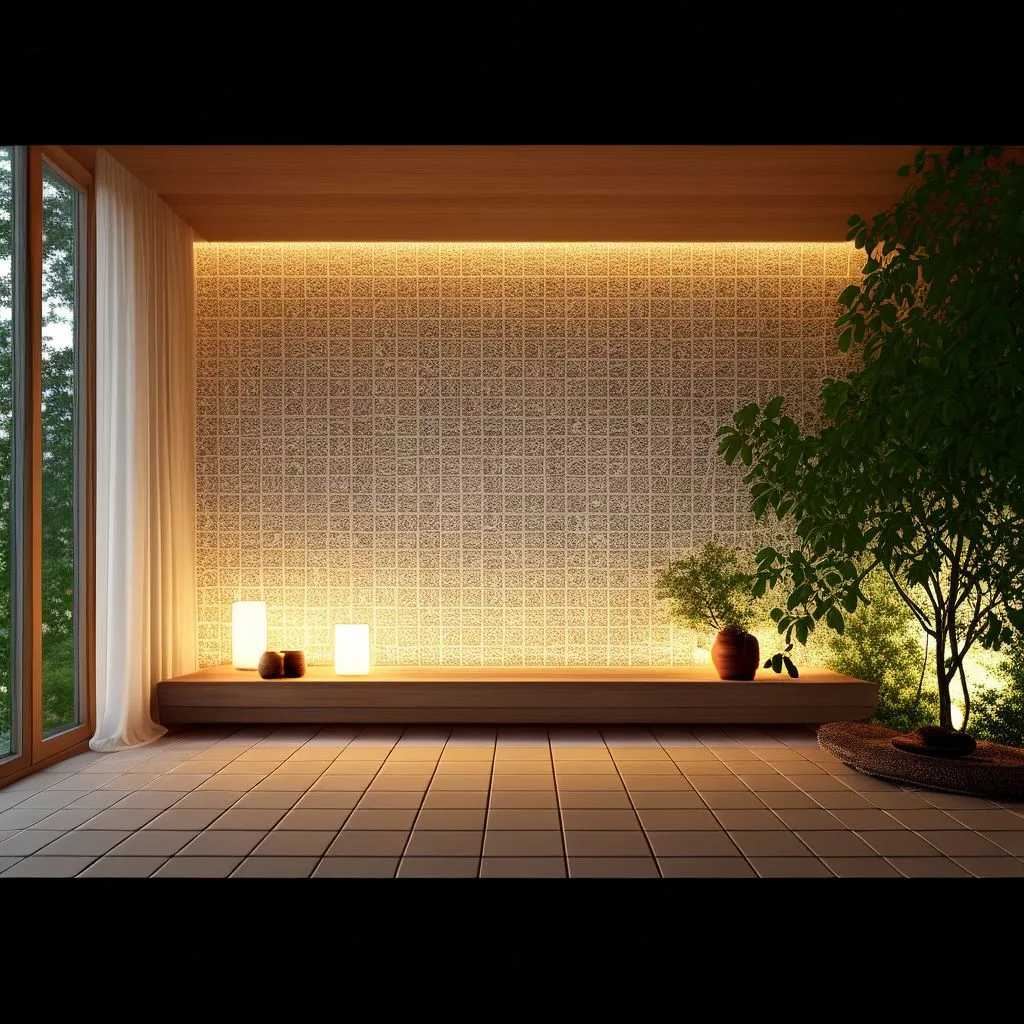Transform your home into a cozy wellness retreat by using natural materials, soft colors, and gentle curves. Choose tiles that resemble nature to help you feel calm and relaxed. Incorporating flowing shapes can create a warm, inviting space, while soothing hues like whites and creams bring peace to your surroundings. As we blend modern design with our need for well-being, we can create personal havens that nourish both body and soul. Let your home be a sanctuary where you can unwind and feel your best!
How Can I Transform My Living Space for Optimal Well-being?
To transform your living space for optimal well-being, consider these key elements:
- Incorporate Natural Materials: Use tiles that mimic nature to reduce stress.
- Find Flow: Opt for curves and organic shapes for comfort.
- Choose Calming Colors: Select soft, soothing hues for a tranquil atmosphere.
Embrace these design principles to create a personal wellness sanctuary.
Wellness Trends in Modern Living
If you’ve spent any time exploring wellness retreats on social media, you’ve likely encountered a slew of unconventional wellness trends. From goat yoga and cupping therapy to sound baths with brass gongs and vampire facials, the array of offerings can be overwhelming. There’s also bee venom therapy and a variety of Amazonian psychedelic brews making waves. And despite our best efforts, the algorithm continues to bombard us with coffee enemas. As we approach 2025, the concept of wellness is integrating more seamlessly into our homes and workplaces. Interior design trends are gravitating towards creating ‘wellness spaces’ that emphasize mindfulness, restoration, and a state of flow. Imagine homes that celebrate our intrinsic need for color, texture, art, and human connection, enabling us to function at our best. We crave wellness, but we want it embedded in personal spaces that resonate with heart and soul.
Crafting Soulful Spaces with Stiles
Stevie Joubert, CEO of Stiles, suggests that there’s a growing demand for creating sensory experiences within our homes. The connection to nature, spatial flow, and spiritual elements are becoming significant considerations for customers. Stevie highlights that the home can serve as a sanctuary where time decelerates, allowing the body to relax. He strongly believes, “If you can see it and visualize it, you can create it!” At Stiles, the goal is to empower customers to tap into their creativity and transform their homes into ultimate wellness retreats. Stevie encourages focusing on tiles that bring personality to a space, infusing it with connection, creativity, depth, and energy.
Stiles’ Top Tips for Wellness-Focused Design
Natural Materials
Incorporating tiles that mimic the textures and colors of raw materials can provide psychological grounding. Humans have an innate affinity for nature, where organic elements help reduce stress and enhance mental clarity. When designing with well-being in mind, consider Stiles’ hyper-expressive stone-look slabs. The Florim porcelain slabs, such as the Rock Salt range, are sustainably produced and capture the natural charm of salt crystals. This collection, inspired by large rock salt blocks from underground mines, features tones like Celtic Grey, White Gold, and Danish Smoke.
Finding the Flow
Curves and organic shapes in interior design can create a sense of softness, fluidity, and natural harmony. Rounded edges, reminiscent of waves, hills, shells, and plants, are associated with comfort and safety. Tiles with flowing forms offer an immersive living experience, alleviating digital stress. Stiles offers reeded, fluted, and rippled decorative tiles like the Funky Tiles Cuore My C Deluxe. Available in shades such as snow, olive, and ochre, these tiles mimic an embracing sense of comfort. The Fluted Marmi porcelain tile, with its marble look and tactile satin finish, and the Fluted Terrazzo tile, with its visually dynamic linear grooves, create soft tonal variations throughout the day. The AB Pietra Antica Strokes tiles, featuring a rippled sea bed pattern, come in cream, light grey, and grey.
Colors to Inspire Calm
To foster a space for reflection and renewal, explore surface coatings that promote balance, clarity, and calm. The Wellness Space Movement emphasizes a palette of soft, soothing hues like whites, creams, and gentle neutrals. These timeless tones exude effortless elegance, inviting light and tranquility into every corner of your home. The Hermes White Natural tile offers a beautifully veined relief texture, imbuing a sense of restfulness. Similarly, the Florim Walks White tile, with its soft stone look and natural finish, and the Tuscania Ceramiche Dolomia White, available in semi-polished, matt, and slip-resistant finishes, provide a serene backdrop.
Historical Context and Modern Parallels
In recent years, wellness has transcended traditional settings like gyms and spas, permeating our daily lives and living spaces. This shift towards integrating mindfulness into our environments mirrors historical and artistic movements that celebrated harmony between humans and their surroundings.
The Arts and Crafts movement of the late 19th century, for instance, emphasized simplicity and the beauty of handmade objects. Reacting against the soullessness of industrialization, this movement promoted natural materials and personalized touches, much like today’s wellness space trend. The focus on natural materials goes beyond aesthetics, rooted in psychology and biology. We are biophilic beings with an inherent tendency to connect with nature. Elements like wood, stone, and plants help reduce stress and enhance mental clarity, a principle reflected in wellness space designs.
Curves and organic shapes, crucial in creating restful environments, are associated with safety and comfort. This concept dates back to ancient architecture and art, where curves symbolized continuity and balance. Similarly, color psychology plays a significant role in promoting calm in wellness spaces. Soft, muted hues create a tranquil atmosphere, encouraging introspection and relaxation. Thoughtfully used, these colors can transform a space into a sanctuary, akin to traditional Japanese Zen gardens.
Holistic Design Philosophy
The integration of wellness into interior design echoes the holistic approach of ancient Greek and Roman architecture. These civilizations designed spaces that catered to the mind, body, and spirit. Modern wellness spaces adopt this philosophy, creating environments that nurture every aspect of our well-being.
Today’s diverse and sometimes unconventional wellness trends, from goat yoga to sound baths, reflect a deeper cultural shift towards valuing mental health and emotional well-being. Incorporating these trends into our living spaces signifies a recognition of the importance of holistic health.
In conclusion, the movement towards wellness spaces is more than a design trend; it’s a reawakening of the understanding that our environments profoundly impact our mental and physical health. By embracing natural materials, organic shapes, and calming colors, we create spaces that nourish our souls. This convergence of aesthetics and well-being marks a significant evolution in how we design our personal spaces, aligning them with our inner needs and aspirations.
Visit any of Stiles’ showrooms or their website to explore these transformative products and start your journey towards creating your own wellness sanctuary.
“`markdown
What are the key elements to transform my living space for optimal well-being?
To transform your living space for optimal well-being, focus on incorporating natural materials, finding flow with curves and organic shapes, and choosing calming colors. These elements work together to create a serene atmosphere that promotes relaxation and mindfulness, turning your home into a personal wellness sanctuary.
How do natural materials contribute to a wellness-focused design?
Natural materials mimic the textures and colors found in nature, helping to reduce stress and enhance mental clarity. By using materials such as wood, stone, and tiles that evoke nature, you can create a psychologically grounding environment that fosters well-being. Products like Stiles’ hyper-expressive stone-look slabs are perfect for achieving this connection to nature.
Why are curves and organic shapes important in interior design?
Curves and organic shapes create a sense of softness, fluidity, and natural harmony, which are essential for a calming atmosphere. These design elements evoke comfort and safety, helping to alleviate stress. Tiles designed with flowing forms, such as reeded or fluted decorative tiles, enhance the overall living experience by promoting a sense of peace.
What color palette should I consider for a calming environment?
To foster a tranquil atmosphere, consider using a color palette of soft, soothing hues like whites, creams, and gentle neutrals. These colors invite light and serenity into every corner of your home, creating a space that encourages reflection and renewal. Options like the Hermes White Natural tile or Florim Walks White tile can help achieve this calming effect.
How does the concept of wellness in design relate to historical movements?
The modern trend of wellness spaces mirrors historical movements, such as the Arts and Crafts movement, which emphasized harmony between humans and their environments. This historical context highlights the enduring importance of natural materials and personalized touches in creating spaces that nurture mental and emotional well-being.
How can I start creating my own wellness sanctuary at home?
Begin by visiting Stiles’ showrooms or website to explore wellness-focused products like natural materials, organic shapes, and calming color options. Embrace your creativity and visualize how you want your space to feel. By incorporating these principles, you can gradually transform your home into a sanctuary that nourishes your body and soul.
“`








